Retail marketing was traditionally about expansion and new markets, but that's changed since the rise of eCommerce. Like a flipped switch, the game is now about retention and customer loyalty. Landing a single sale isn't enough when your competition is nearly infinite, and they're all just a click away. And because it costs five times more to attract a new customer than to retain an existing one, the shift makes sense.
The best eCommerce brands are attracting new customers while simultaneously keeping the old ones happy. Here, we'll outline seven must-have marketing strategies an eCommerce company needs to bring in new customers and then keep them loyal.
1. Identify and Broadcast What Makes Your Brand Unique
Before you begin marketing, you need to cement your value proposition—that is, the differentiator that sets you apart from the competition.
For some companies, it's product range: offering exclusive or hard-to-find items or services that other brands don't. For others, it's product quality, speedy shipping, above-and-beyond customer service, or low prices. Or maybe your differentiator is more creative. Regardless, the first step is you knowing what differentiates your brand from your competitors. In theory, this is built in to your initial business model, so chances are you've already identified it.
The next step is communicating your value proposition to your audience. However you do it—through a slogan, with poignant visuals, or otherwise—the key is consistency. You'll use your various marketing channels in different ways, but you should always be touting the same value proposition. That's what's at the core of your brand.
NOVO Watch is a great example. Their value proposition lies in the quality of their products: Unlike their competitors, NOVO Watch makes their timepieces from authentic historical artifacts such as train tracks or military equipment. They're also proud of their process: All pieces are made by hand in the company's home province of Alberta.
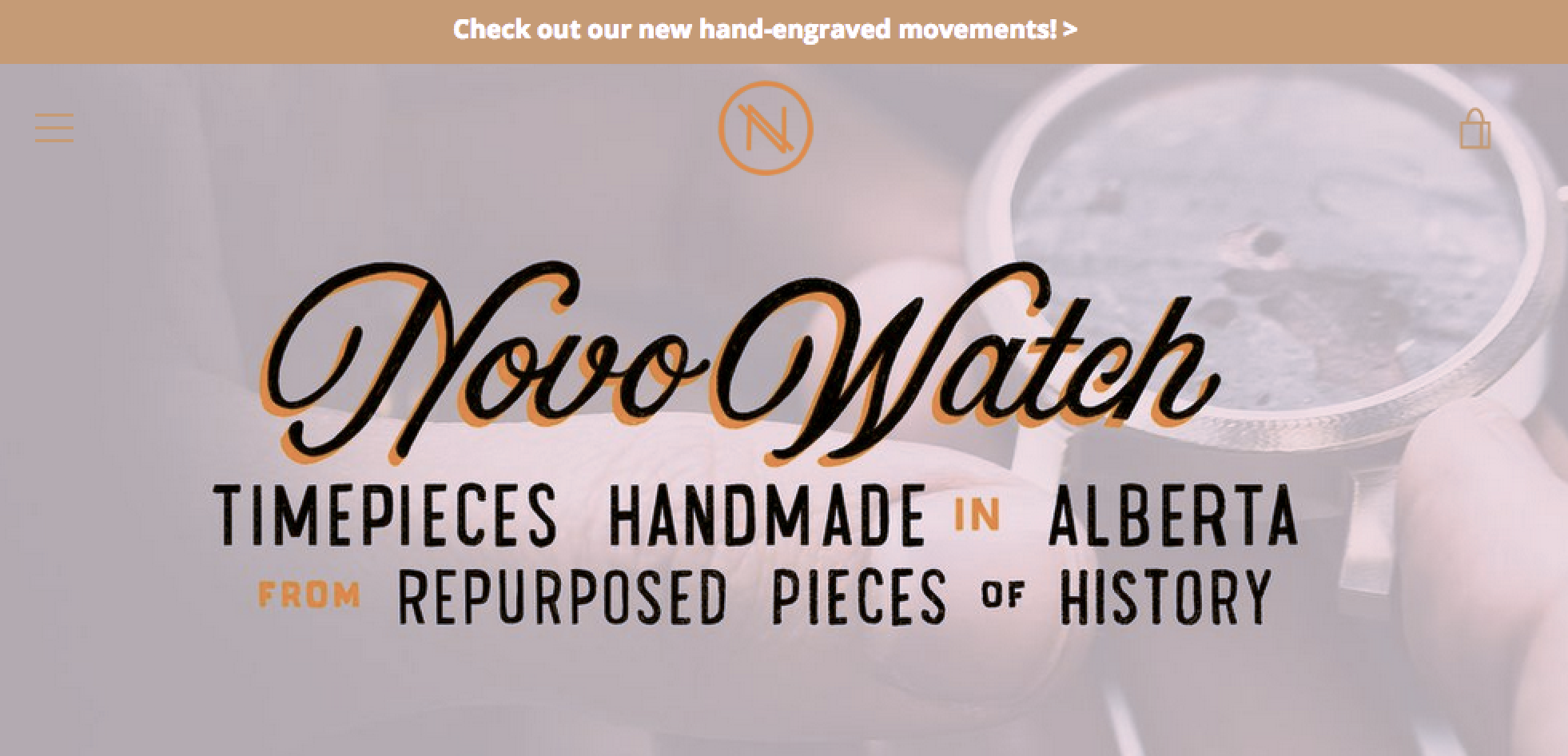
These differentiators are immediately evident in their marketing, with a succinct and pithy slogan that's interwoven into their logo. Not only do the words communicate the value proposition efficiently, but they're also designed with suggestive typography that matches the old-fashioned brand personality befitting of a company that deals in historical antiques.
Authenticity wins these days. The more authentic you are, the more your value proposition flows through the product and branding. Customers are smart, and can quickly pick up on empty stories. Simply understanding who you are and being true to what you believe as a company not only keeps the messaging clear, but also attracts like-minded customers to shop with you. - Steve Christensen, Founder of NOVO Watch
And because their value proposition is an integral part of their logo, they can seamlessly broadcast it on all their channels. Their logo and slogan appear consistently on their home page, social media profiles, and other marketing channels.
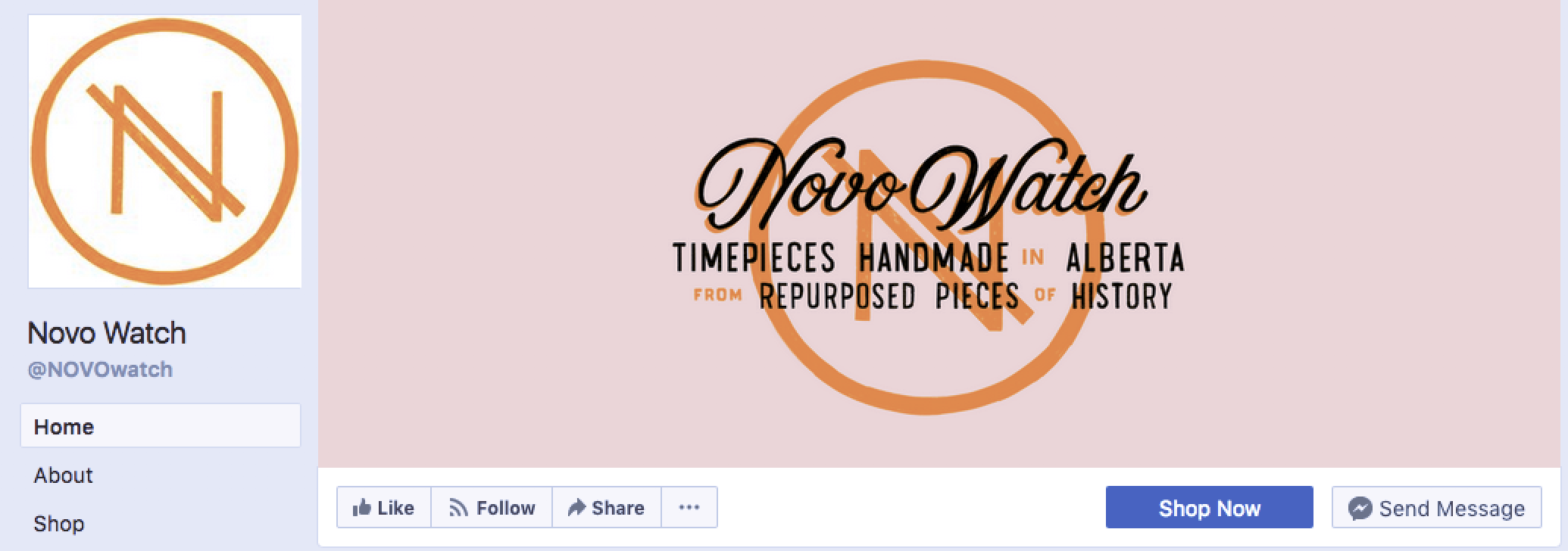
2. Write Blog Posts That Satisfy Both Customers and SEO
Blogging and content marketing in general are among the most effective and cost-efficient methods of marketing. Digital marketing guru Neil Patel agrees, based on some eye-opening statistics he collected:
- 70% of people prefer to learn about new products through custom content.
- Blogging consistently generates 88% more leads for B2B companies and 67% more leads for B2C companies.
- Website conversion rate is almost 6x higher for adopters of content marketing than non-adopters (2.9% vs. 0.5%).
But simply having a blog is not enough, as many frustrated eCommerce companies have already discovered. Creating successful content marketing campaigns is more about how you use your blog.
For one thing, as a big pile of text, blogs are perfect for SEO. You can fill your website with all the core keywords and search terms that potential and existing customers are likely to enter into Google. Of course SEO has its own nuanced techniques, but if you hire a skilled writer, they'll know how to handle them.
Even more important, you need to release content that's relevant to your target customers. It's tempting to build content around self-promotion, but that's putting the cart before the horse. Your blog's top priority is engaging customers by providing articles they genuinely want to read. That's the strategy Au Lit Fine Linens uses with their blog, "Between the Sheets."
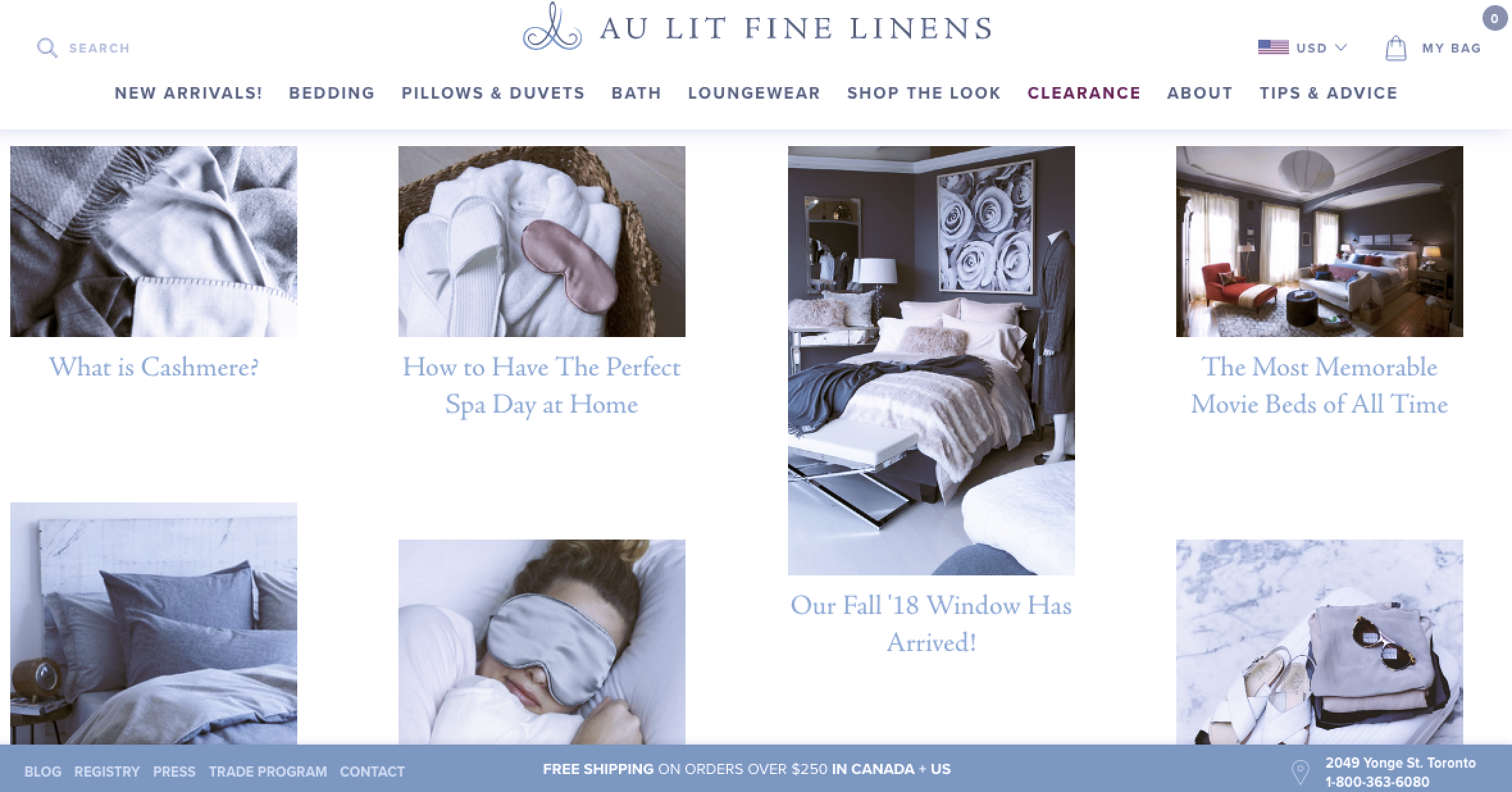
Au Lit Fine Linens has a balanced mix of initiatives in their blog. They publish articles that make shopping for bedsheets easier; for example, "Mother's Day Gift Guide" or "How to Master Mixing and Matching in the Bedroom." They also have more fun and casual—but still relevant—articles like "The Most Memorable Movie Beds of All Time." And while they do include self-promotional articles, like "Introducing Au Lit Bundles," those pieces aren't the primary purpose of the blog.
But perhaps most impressive is the way they subtly incorporate long-tail keywords—keywords that are more specific—into their blog without disrupting the typical user experience. Blog articles like "What's the Difference Between a Duvet and a Comforter?" and "What Sheets Will Keep Me Cool All Summer Long?" are all relevant to the blog and of interest to the typical customer, but they're also wins for SEO.
To save time promoting your blog, you can automate the promotion process using Zapier. Set up an automated workflow—or Zap—that posts to social media every time you publish a new article to your blog:
3. Complement Marketing Campaigns with Referral Programs
The best advertisements aren't advertisements at all. According to a Nielsen Global Trust in Advertising Report, the most trusted source of product recommendations comes from friends and family.
Modern marketers have caught on and are implementing referral programs more than ever before. Referral programs leverage consumers' trust in their peers: By offering an incentive to the referrer, you can increase the amount of word-of-mouth advertising you receive—and the conversions that come with it.
Referral marketing is great for expansion, considering that the friends and family of your customers are more likely to fit your target customer profile and become loyal customers themselves. And because the recommendations come from a trusted source, you deal with less resistance.
The online footwear brand GREATS has seen a lot of success with their referral program, which reflects the trend of sharing the benefits with the referrer and the referree.
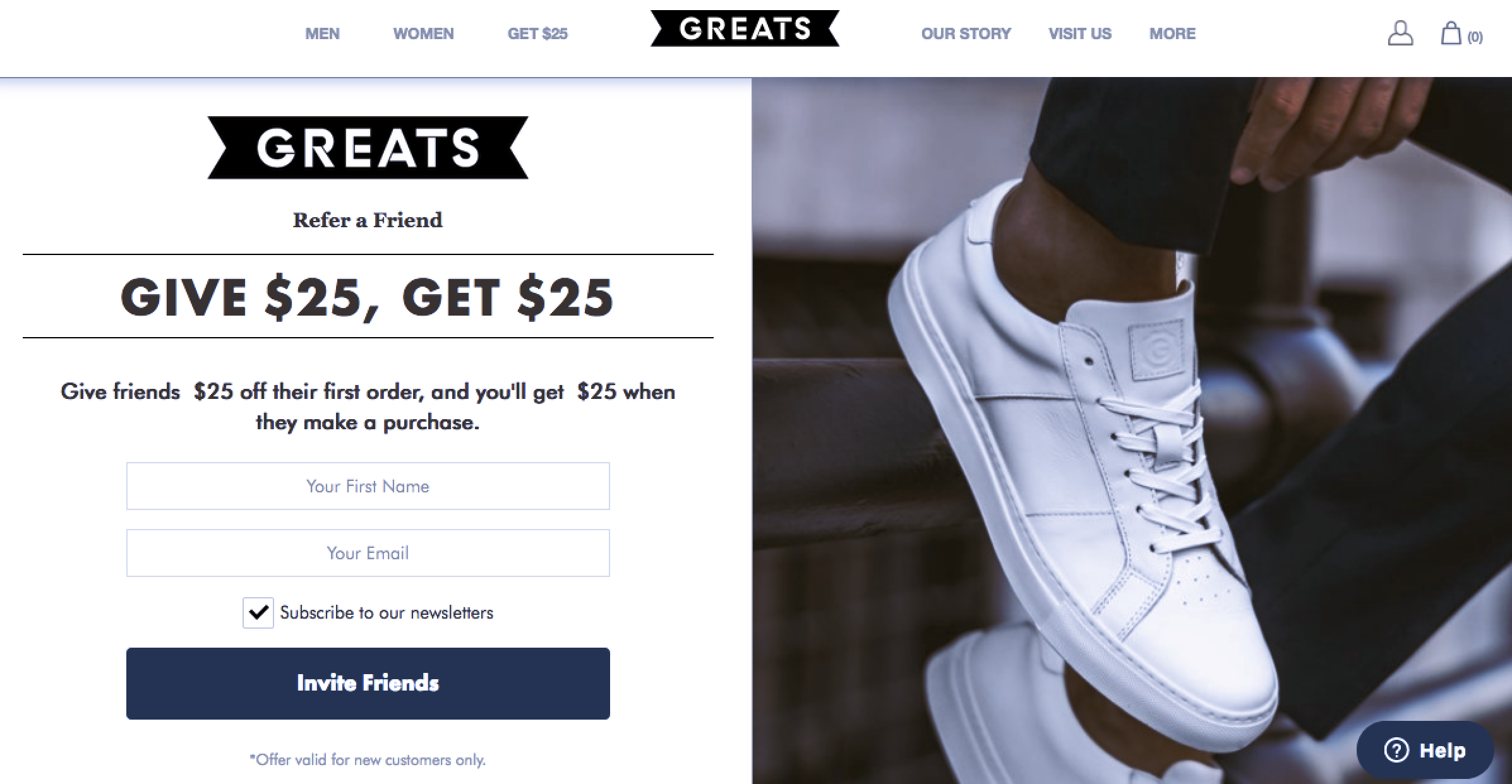
Introducing new customers to your brand with a discount makes a stellar first impression. The company will make up the $25 loss with repeat purchases from not one but two loyal customers.
4. Enlist Influencers to Advertise for You
Friends and family aren't the only trusted sources that can help promote your product or service. In the golden age of social media, influencer marketing is becoming one of the top methods for spreading brand awareness.
Influencers are popular online personas who have a significant sway on their followers. They often get to their position by reliably giving good advice in their areas of specialization: Fashion influencers suggest new clothing trends, tech influencers give accurate reviews of new gadgets, and so on. Online marketers seek them out to promote their products, with effective results. If a trusted influencer says something is true, their followers tend to take it for fact without argument. According to One Production, the ROI on influencer marketing can be up to 11x higher than traditional advertising, and 94% of marketers who use influencer marketing find it effective.
That's influencer marketing on a large scale, but the practice has since evolved to incorporate influencers on a grassroots level as well. "Micro-influencers" are regular people promoting a product on social media, raising brand awareness one "like" at a time. While they lack the massive reach of more prominent influences, micro-influencers can add up if you have enough of them, particularly if you run a widespread campaign encouraging user-generated content.
Because influencer marketing increases the online discussion of your brand—in a positive light—it's as good for customer retention as it is for impressing new customers. For first-time customers, your brand gets a vote of confidence from a trusted source; for existing customers, the repeated mentions online remind them why they shopped with you before.
Sephora is known for its influencer marketing. As a seller of beauty products—an industry naturally conducive to influencer marketing and peer recommendations—Sephora has a long tradition of embracing influencers and even the progressing the standards of working with them.

As fashion and beauty blog Glossy explains, Sephora's current influencer marketing campaign spans three tiers of influencer types. At the top of the pyramid is the Sephora Pro Team, a handpicked group of fifteen highly-regarded makeup artists who work in-house with Sephora. At the next level are the external social media influencers hired by Sephora to test, review, and discuss their products, sometimes even curating special collections. Last is the pool of micro-influencers, some of whom are paid, others receiving only swag.
More than most companies, Sephora understands the value of social opinion. Their three-tiered influencer program accounts for each point of the spectrum, from verified experts to peer recommendations.
5. Encourage Newsletter Signups for a Direct Connection to Shoppers
Attracting new customers revolves around getting your name out there and making a good first impression. Retaining existing customers, on the other hand, is about personal relationships.
As a whole, email is more intimate than other mediums: Instead of a public broadcast, it's a message sent straight to your inbox. That's part of the appeal of the email newsletter. There may be hundreds or even thousands of names on the send list, but to the recipient, it feels like a message that's just for them.
Email marketing apps allow you to personalize your messages and create drip campaigns that change based on user actions. But regardless of the software you use, the key to a successful newsletter campaign is providing content that your customers actually want to read—otherwise it's just spam, and you're damaging your brand image more than helping it.
There are plenty of ways to make newsletters useful:
- Offer exclusive discounts.
- Present a "ticking clock" to encourage immediate action.
- Provide personalized product recommendations.
- Announce new products.
- Feature blog articles.
Take a look at this email newsletter from Crocs. They offer an exclusive deal to customers, making the email worth opening in the first place. The design is branded and grabby, and the discount is front-and-center. The technical considerations are all in line as well. For example, users can go directly to different product category pages (e.g., "new arrivals," "women," etc.) from the links provided.
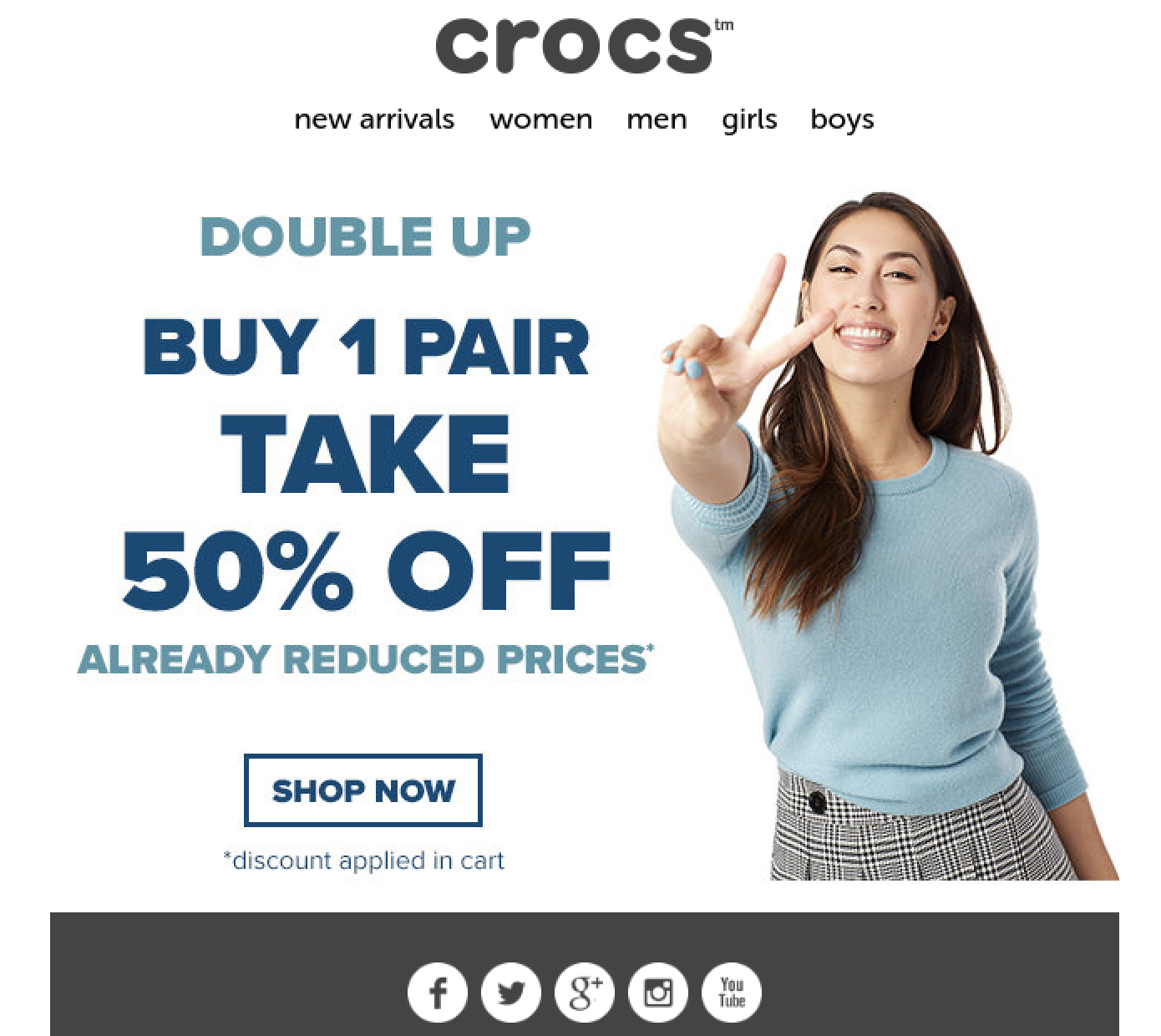
The best part is the single-click shopping option: Shoppers only have to click the "Shop Now" link to apply their discount automatically. That's one less step the customer has to take themselves, and each redundant step you remove from the sales process can increase your conversion rate.
6. Use Social Media for One-on-One Customer Engagement
Whether you're answering questions, addressing complaints, offering personalized recommendations, or just engaging in playful banter, social media allows you to have genuine, back-and-forth conversations with your customers.
Remember: Social media is about personality. Straight-up sales tactics don't tend to work as well in social feeds. People prefer to see posts that entertain and engage, not thinly veiled ads. That applies to commenting as well: It's best to respond to comments with a casual and human voice rather than something generic you might expect from a chatbot.
As an example, see how the trendsetting beauty brand Frank Body uses social media. Across all their channels, they maintain the same character and themes: sexual, funny, and with a charming "frankness." Their posts are a mixture of sexy-risque images, product promotions, and comedically irreverent quote snippets—all of which work together to create a distinct brand personality that makes following Frank Body like following an eccentric stranger you met at a party.
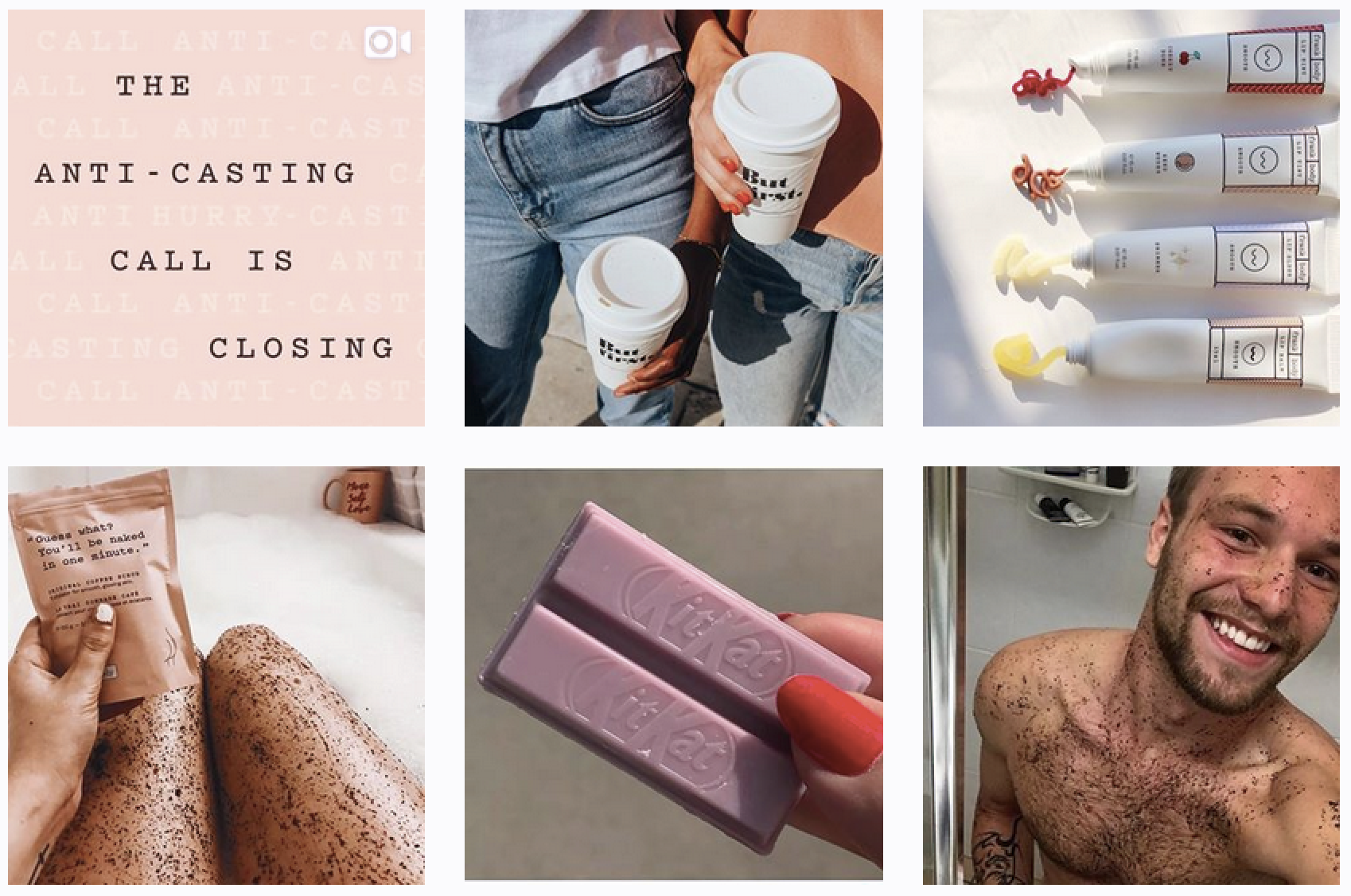
Using social media effectively requires as much listening as it does talking. Frank Body encourages and supports their fans and customers when they talk about their products. This has a beneficial domino effect: Other customers, new and old, see how Frank Body retweets their followers' posts, and want to get in on the exchange by posting their own promotional content.
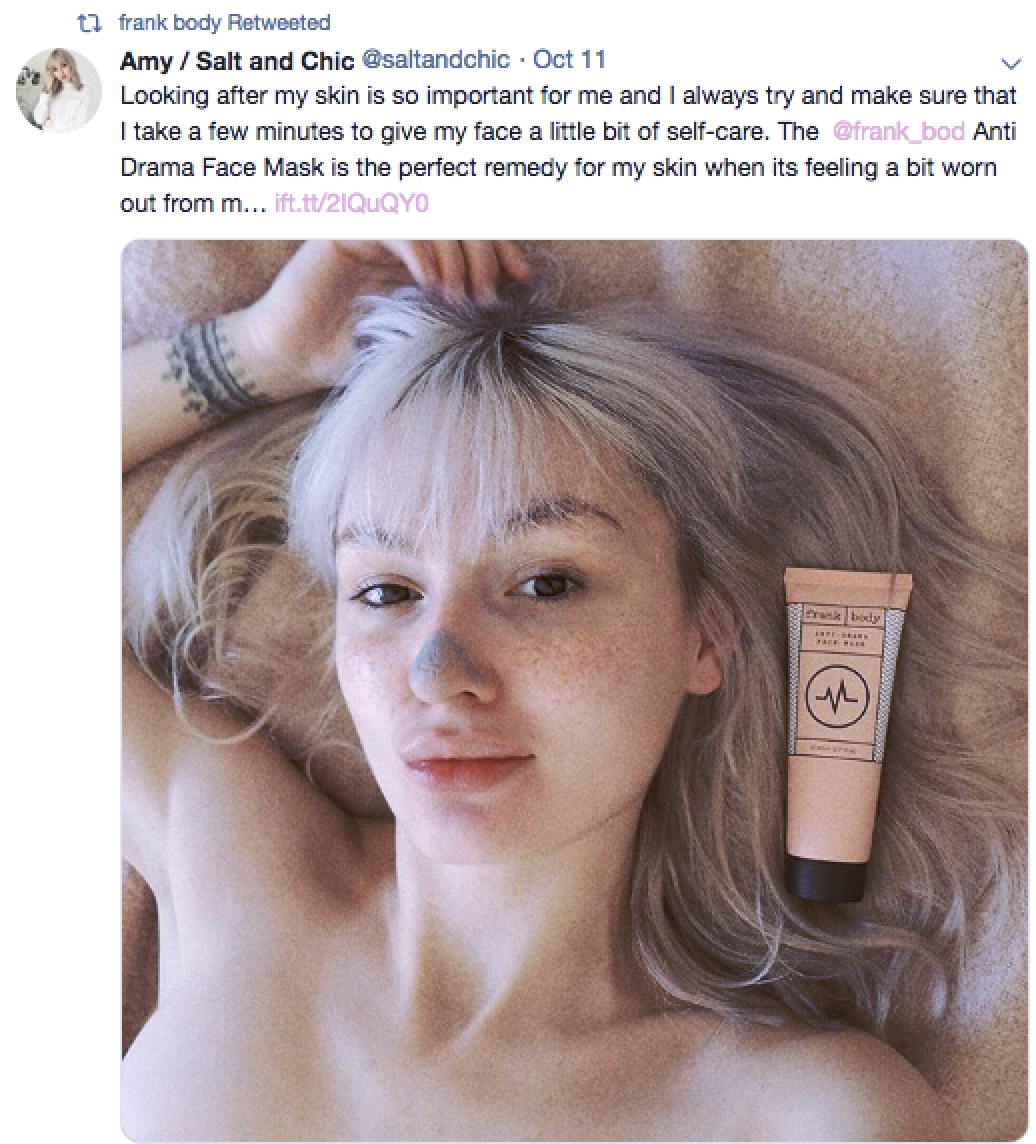
Of course, social media management takes time. But you can trim the fat by automating the process. For example, get notified every time you have a new follower so you can send them a personalized message. Automatically publish the same content on multiple channels. Or even save all your posts to the cloud so you can use them in other marketing channels down the road.
To get started, take a look at Zapier's automated workflows for Facebook, Twitter, Instagram, and LinkedIn.
7. Turn Customer Service and Lenient Return Policies into a Marketing Tool
The best way to promote customer loyalty? Just be nice.
Offering extra benefits like lenient return policies and accommodating customer service can work wonders for your business. On the flipside, bad customer service can be detrimental. According to HelpScout, after just a single bad customer service experience, about a third of Americans say they will consider switching brands, and just over half say they will never do business with that company again.
For eCommerce, customer-centric return/refund policies are becoming the new norm. Considering the inherent risk in shopping online—you don't know exactly what you're getting until after you click Purchase—offering more relaxed return/refund policies is a direct way to put shoppers at ease and give them the confidence to add more items to their cart. Plus, it can actually lead to fewer returns.
How accommodating your customer service is with complaints also has a ripple effect. When all is said and done, offering a refund may cost less than losing all future business from that customer. Because of fierce competition, if your customer service doesn't meet your customer's demands, they'll find another store that does.
Even in the absence of problems, customer service can improve the online shopping experience. A few years ago, features like chat or help desks were seen as something extra, but now customers are coming to expect them. At the very least, you should select high-quality customer service software to cover the minimum expectations of modern online shoppers.
Who do we have to thank for raising the bar on customer service and returns? None other than eCommerce leader Amazon.
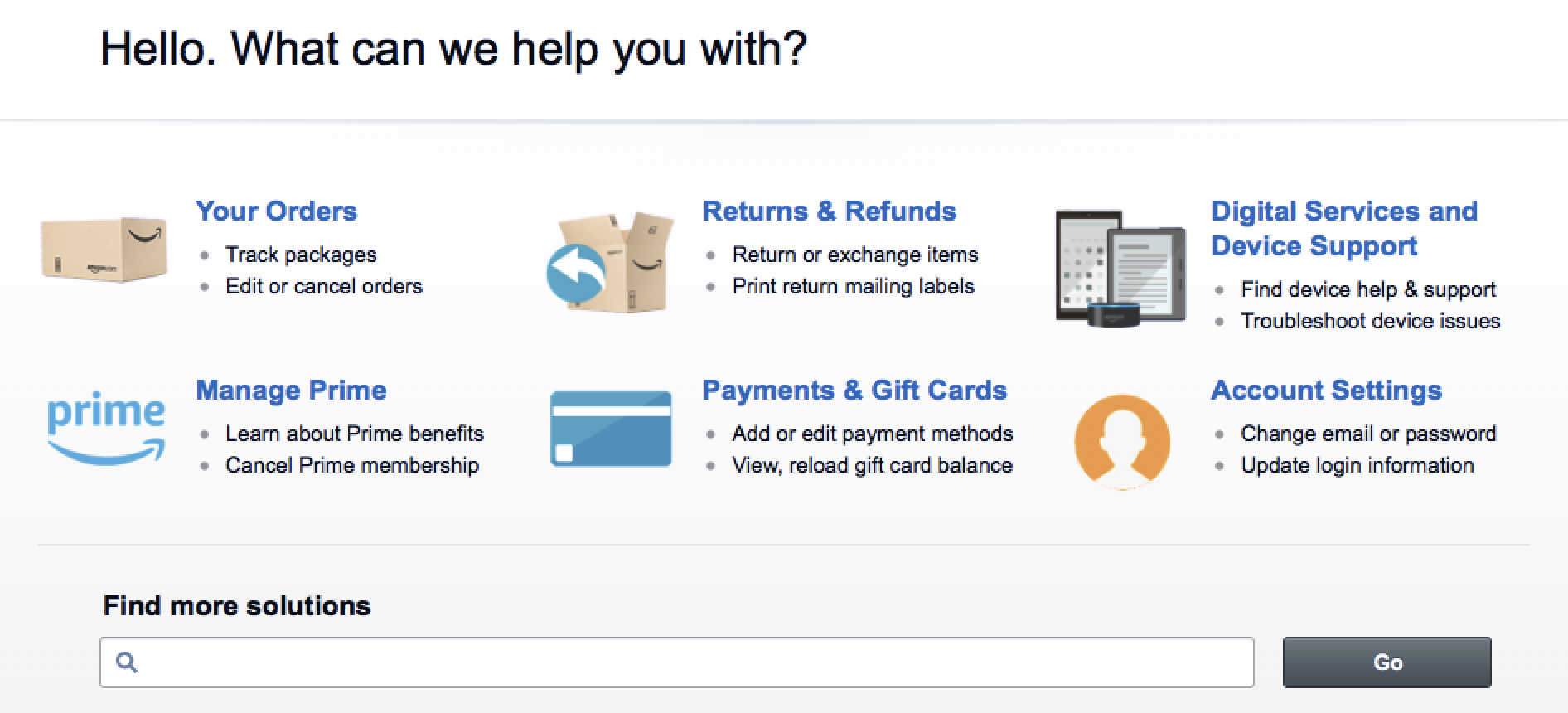
For one thing, Amazon allows returns on "most new, unopened items sold and fulfilled by Amazon within 30 days of delivery for a full refund." But that's just the tip of the iceberg. Their reps are encouraged to go above and beyond for clients, addressing their concerns with more personal investment than most other companies. And founder, Jeff Bezos, along with thousands of other managers undergo call-center training every year.
What do these essential eCommerce marketing strategies have in common? They all revolve around the customer. By prioritizing this customer-first mindset, you'll earn and maintain a loyal customer base, and your business will benefit as much as your customers do.
Image of Crocs newsletter via Omnisend. Image of Kyrah Stewart via Zimbio.
source https://zapier.com/blog/ecommerce-marketing/

No comments:
Post a Comment